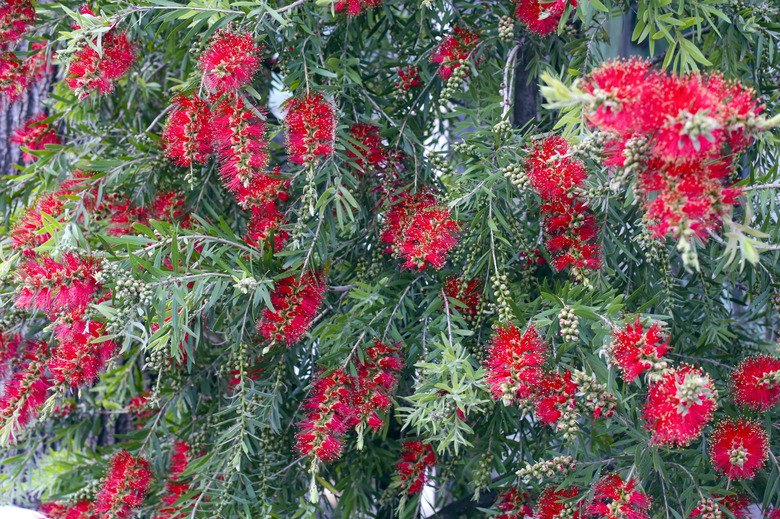How To Prune A Bottlebrush Shrub
We may receive a commission on purchases made from links.
Bottlebrush shrubs (Callistemon spp.) produce highly ornamental flowers and foliage. Most varieties have fine, feathery leaves and produce long red or yellow pollen stalks, or filaments, that resemble the spiky brush used to clean bottles. Bottlebrush shrubs grow in U.S. Department of Agriculture plant hardiness zones 10 and 11. These shrubs bloom on new wood, so minor pruning can keep them flowering for an entire summer season.
Preparing to Prune
Preparing to Prune
Standard hand pruners or bypass shears work well for general annual maintenance pruning. Unless the shrub is badly overgrown and needs severe rejuvenation pruning, most cuts are through small stems, so you won't need a pruning saw. If you must cut through branches between 3/4 and 1 inch in diameter, use lopping shears. Wipe all pruning tools with a cloth soaked in isopropyl alcohol before pruning and before pruning a different bottlebrush tree to prevent the spread of pests and diseases.
Tip Pruning Bottlebrush Shrubs
Tip Pruning Bottlebrush Shrubs
A healthy, well-shaped bottlebrush tree only requires annual tip pruning during the first one to three years of the establishment phase to create a healthy, full framework of branches. Tip prune in late winter, before the buds begin to swell, Cut off the tips of the branches back to within 1/4 inch of a bud, but avoid cutting into the old wood that no longer produces new buds. You may be pruning off some flowers, because bottlebrush flowers only on new wood, but the resulting shrub develops a fuller shape and more flowering branches that will provide more blooms in the future.
Deadheading Bottlebrush Flowers
Deadheading Bottlebrush Flowers
Bottlebrushes can flower repeatedly throughout the summer if you keep them deadheaded. Remove the old, spent flowers as soon as they start to fade, before the next flush of growth and flower buds begin to form. Make a cut just behind each bottlebrush flower at the first signs of wilting and decline. New growth emerges from this cut, resulting in a new bloom. Avoid fall deadheading if there is any chance of winter frost in your area, because a flush of new fall growth will suffer damage or die when temperatures dip below freezing. Instead, remove the last fall flowers in late winter as you would with tip pruning.
Rejuvenating Bottlebrush Shrubs
Rejuvenating Bottlebrush Shrubs
Badly overgrown bottlebrushes can sometimes grow back into full, healthy shrubs after severe rejuvenation pruning. It's best to only rejuvenate bottlebrushes if the alternative is removing the shrub entirely, because not all plants will survive severe pruning. Cut back the entire shrub to the ground in winter before any new growth appears. If the shrub survives, new stems that can produce leaves and flowers will emerge from the base of the plant when spring growth resumes.
